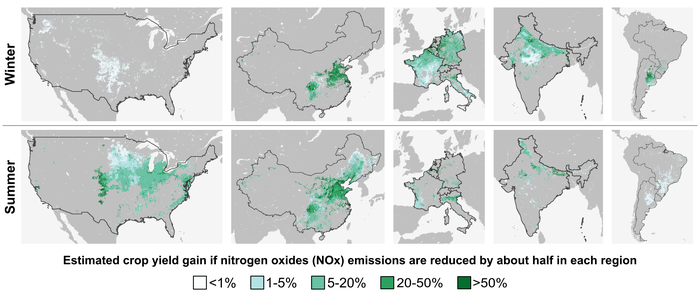Usually, increasing agricultural productivity depends on adding something, such as fertilizer or water. A new Stanford University-led study reveals that removing one thing in particular – a common air pollutant – could lead to dramatic gains in crop yields. The analysis, published June 1 in Science Advances, uses satellite images to reveal for the first time how nitrogen oxides – gases found in car exhaust and industrial emissions – affect crop productivity. Its findings have important implications for increasing agricultural output and analyzing climate change mitigation costs and benefits around the world.

Credit: Lobell, et al. / Science Advances
Usually, increasing agricultural productivity depends on adding something, such as fertilizer or water. A new Stanford University-led study reveals that removing one thing in particular – a common air pollutant – could lead to dramatic gains in crop yields. The analysis, published June 1 in Science Advances, uses satellite images to reveal for the first time how nitrogen oxides – gases found in car exhaust and industrial emissions – affect crop productivity. Its findings have important implications for increasing agricultural output and analyzing climate change mitigation costs and benefits around the world.
“Nitrogen oxides are invisible to humans, but new satellites have been able to map them with incredibly high precision. Since we can also measure crop production from space, this opened up the chance to rapidly improve our knowledge of how these gases affect agriculture in different regions,” said study lead author David Lobell, the Gloria and Richard Kushel Director of Stanford’s Center on Food Security and the Environment.
A NOx-ious problem
Nitrogen oxides, or NOx, are among the most widely emitted pollutants in the world. These gases can directly damage crop cells and indirectly affect them through their role as precursors to formation of ozone, an airborne toxin known to reduce crop yields, and particulate matter aerosols that can absorb and scatter sunlight away from crops.
While scientists have long had a general understanding of nitrogen oxides’ potential for damage, little is known about their actual impacts on agricultural productivity. Past research has been limited by a lack of overlap between air monitoring stations and agricultural areas, and confounding effects of different pollutants, among other challenges to ground-based analysis.
To avoid these limitations, Lobell and his colleagues combined satellite measures of crop greenness and nitrogen dioxide levels for 2018-2020. Nitrogen dioxide is the primary form of NOx and a good measure of total NOx. Although NOx is invisible to humans, nitrogen dioxide has a distinct interaction with ultraviolet light that has enabled satellite measurements of the gas at a much higher spatial and temporal resolution than for any other air pollutant.
“In addition to being more easily measured than other pollutants, nitrogen dioxide has the nice feature of being a primary pollutant, meaning it is directly emitted rather than formed in the atmosphere,” said study co-author Jennifer Burney, an associate professor of environmental science at the University of California, San Diego. “That means relating emissions to impacts is much more straightforward than for other pollutants.”
Calculating crop impacts
Based on their observations, the researchers estimated that reducing NOx emissions by about half in each region would improve yields by about 25% for winter crops and 15% for summer crops in China, nearly 10% for both winter and summer crops in Western Europe, and roughly 8% for summer crops and 6% for winter crops in India. North and South America generally had the lowest NOx exposures. Overall, the effects seemed most negative in seasons and locations where NOx likely drives ozone formation.
“The actions you would take to reduce NOx, such as vehicle electrification, overlap closely with the types of energy transformations needed to slow climate change and improve local air quality for human health,” said Burney. “The main take-home from this study is that the agricultural benefits of these actions could be really substantial, enough to help ease the challenge of feeding a growing population.”
Previous research by Lobell and Burney estimated reductions in ozone, particulate matter, nitrogen dioxide, and sulfur dioxide between 1999 and 2019 contributed to about 20% of the increase in U.S. corn and soybean yield gains during that period – an amount worth about $5 billion per year.
Future analysis could incorporate other satellite observations, including photosynthetic activity measured through solar-induced fluorescence, to better understand nitrogen dioxide’s effects on crops’ varying degrees of sensitivity to the gas throughout the growing season, according to the researchers. Similarly, more detailed examination of other pollutants, such as sulfur dioxide and ammonia, as well as meteorological variables, such as drought and heat, could help to explain why nitrogen dioxide affects crops differently across different regions, years, and seasons.
“It’s really exciting how many different things can be measured from satellites now, much of it coming from new European satellites,” said study coauthor Stefania Di Tommaso, a research data analyst at Stanford’s Center on Food Security and the Environment. “As the data keep improving, it really drives us to be more ambitious and creative as scientists in the types of questions we ask.”
Lobell is also a professor of Earth system science in Stanford’s School of Earth, Energy & Environmental Sciences, the William Wrigley Senior Fellow at the Stanford Woods Institute for the Environment, and a senior fellow at the Freeman Spogli Institute for International Studies and the Stanford Institute for Economic Policy Research. Burney also holds the Marshall Saunders Chancellor’s Endowed Chair in Global Climate Policy and Research at UC San Diego and is a research affiliate at UC San Diego’s Policy Design and Evaluation Laboratory, a fellow at the Stanford Center on Food Security and the Environment, and head of the Science Policy Fellows Program at UC San Diego.
This research was funded by NASA and the National Science Foundation.
Journal
Science Advances
Article Title
Globally ubiquitous negative effects of nitrogen dioxide on crop growth
Article Publication Date
1-Jun-2022




